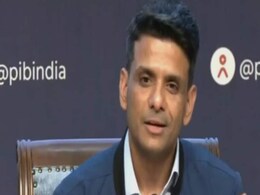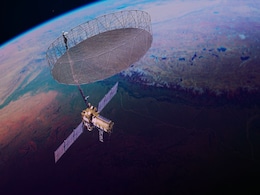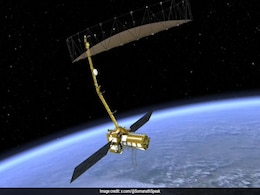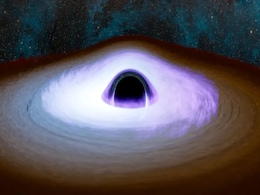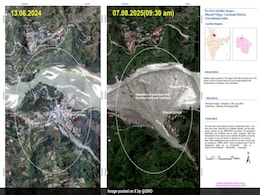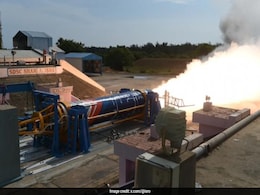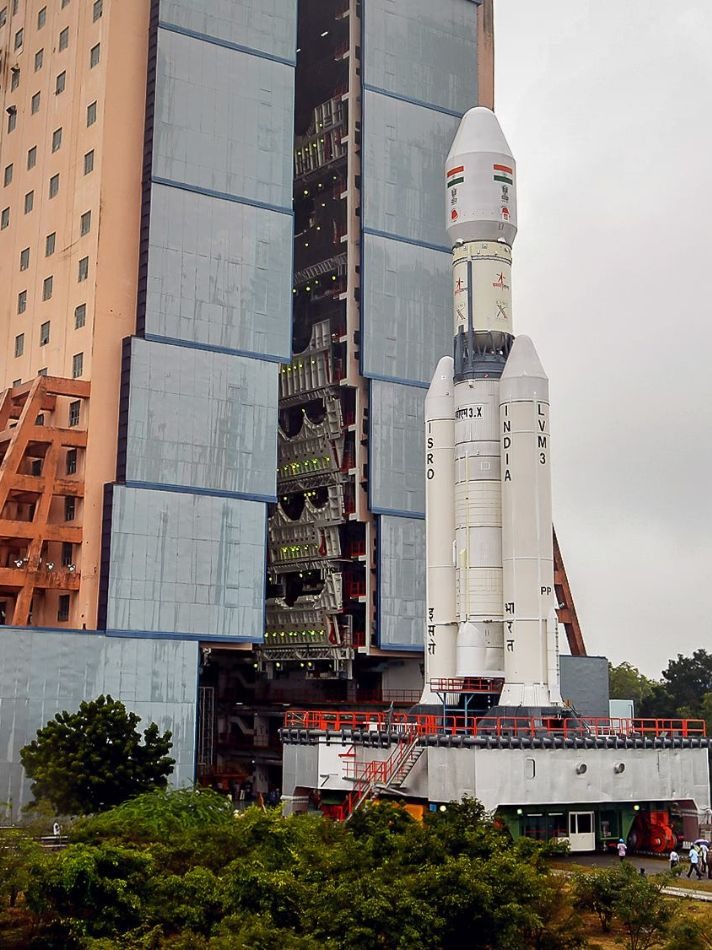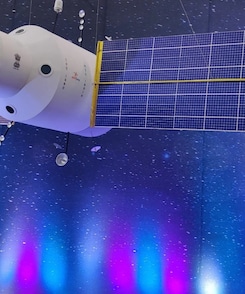Space Research
- All
- News
- Videos
- Photos
- Web Stories
-

"It Was Entire Nation's Mission": Shubhanshu Shukla On Visiting Space Station
- Thursday August 21, 2025
- India News | Edited by Anwesha Singh
Group Captain Shubhanshu Shukla, India's first astronaut to visit the International Space Station as part of the Axiom-4 mission, described his journey as a mission for the entire nation.
-
 www.ndtv.com
www.ndtv.com
-

Hubble Discovers White Dwarf Merger Remnant with Unusual Carbon Signature
- Friday August 22, 2025
- Written by Gadgets 360 Staff
An international team of astronomers has discovered WD 0525+526, an unusual white dwarf about 128 light-years away, using NASA’s Hubble Space Telescope. Unlike typical white dwarfs, this star formed through a stellar merger and shows an unexpectedly high carbon content. With a mass of 1.2 Suns and a scorching surface temperature of 21,000 K, the ...
-
 www.gadgets360.com
www.gadgets360.com
-

NASA-ISRO Earth Observation Satellite Unfolds Giant Radar Antenna in Space
- Tuesday August 19, 2025
- Written by Gadgets 360 Staff
NASA and ISRO’s joint NISAR mission has successfully deployed its 12-meter radar reflector in orbit. This unique satellite, carrying dual L-band and S-band radars, will monitor Earth’s glaciers, volcanoes, earthquakes, and ecosystems with unmatched accuracy. The milestone reflects decades of research and showcases the strength of U.S.-India spa...
-
 www.gadgets360.com
www.gadgets360.com
-

How ISRO Is Touching Lives: Parliament To Debate Space Programmes Today
- Monday August 18, 2025
- India News | Reported by Pallava Bagla
The Indian Space Research Organisation (ISRO), once a modest initiative launched from a church in a fishing village in Thumba, Kerala, has now become a global symbol of frugal innovation and technological excellence.
-
 www.ndtv.com
www.ndtv.com
-

NASA-ISRO's $1.3 Billion Satellite NISAR Deploys Its Antenna In Orbit
- Saturday August 16, 2025
- India News | Reported by Pallava Bagla
In a landmark moment for global Earth science and international space collaboration, the world's most expensive civilian Earth imaging satellite-the NASA-ISRO Synthetic Aperture Radar (NISAR)-has successfully deployed its radar antenna in orbit.
-
 www.ndtv.com
www.ndtv.com
-

NASA’s PUNCH Mission Completes Final Orbit Manoeuvres, Opens Early Sun Data to the Public
- Sunday August 17, 2025
- Written by Gadgets 360 Staff
NASA’s PUNCH mission has reached full operational status, enabling continuous monitoring of the Sun and solar wind from multiple vantage points around Earth. This collaborative effort complements other major solar missions and promises valuable insights into the Sun–Earth connection. Early public release of PUNCH’s science data marks an excit...
-
 www.gadgets360.com
www.gadgets360.com
-

NASA’s IXPE Challenges Theories on Black Hole Corona and Polarised X-Ray Emissions
- Saturday August 16, 2025
- Written by Gadgets 360 Staff
NASA’s Imaging X-ray Polarimetry Explorer (IXPE) has made surprising observations in a black hole binary system, detecting a high degree of X-ray polarisation that challenges current models of corona structure and accretion discs. In X-ray binaries, black holes pull matter from nearby stars, forming hot accretion discs and coronas.
-
 www.gadgets360.com
www.gadgets360.com
-

New Video Shows Exact Moment Uttarkashi Flood Engulfed Dharali Village
- Wednesday August 13, 2025
- India News | Edited by NDTV News Desk
A new video from old Dharali showing the exact moment a deadly wall of water and debris smashed the Uttarkashi settlement on August 5, sending residents scrambling for safety and engulfing the village within seconds, has surfaced.
-
 www.ndtv.com
www.ndtv.com
-

Remembering Father Of Indian Space: How Vikram Sarabhai Built Indian Space Research Organisation From Scratch
- Tuesday August 12, 2025
- India News | Edited by Anwesha Singh
On August 12, the nation remembered and celebrated the 106th birth anniversary of Dr Vikram Sarabhai, the legendary physicist, and widely known as Father of India's Space Programme.
-
 www.ndtv.com
www.ndtv.com
-

ISRO Pics Show Impact Of Floods On Uttarakhand's Dharali, Bhagirathi River
- Monday August 11, 2025
- India News | NDTV
The Indian Space Research Organisation has released satellite images from before and after flashfloods and landslides in Uttarakhand's Uttarkashi district in the first week of August.
-
 www.ndtv.com
www.ndtv.com
-

NASA To Build Nuclear Reactor On Moon By 2030, Here's Why
- Monday August 11, 2025
- World News | The Conversation
The first space race was about flags and footprints. Now, decades later, landing on the Moon is old news. The new race is to build there, and doing so hinges on power.
-
 www.ndtv.com
www.ndtv.com
-

ISRO Chief Shares Key To Success With Students. Here's What He Said
- Monday August 11, 2025
- India News | Asian News International
'No matter the heights you achieve, let honesty be the cornerstone of your success,' emphasised Dr. Narayanan, Chairman, ISRO, during the 21st Convocation Ceremony held at SRM Institute of Science and Technology (SRMIST), Chennai.
-
 www.ndtv.com
www.ndtv.com
-

ISRO Announces Successful Static Test Of Skyroot's KALAM 1200 Rocket Motor
- Saturday August 9, 2025
- India News | Asian News International
ISRO on Friday announced that Skyroot Aerospace has successfully carried out the first static test of its powerful KALAM 1200 solid rocket motor, the first stage of the Vikram-1 launch vehicle, at the Satish Dhawan Space Centre (SDSC), Sriharikota.
-
 www.ndtv.com
www.ndtv.com
-

NASA Wants Nuclear Reactor On Moon By 2030. Here's Why That Matters
- Friday August 8, 2025
- World News | Associated Press
Nuclear power in space isn't a new idea. Since the 1960s, the US and the Soviet Union have relied on radioisotope generators that use small amounts of radioactive elements to power satellites.
-
 www.ndtv.com
www.ndtv.com
-

"It Was Entire Nation's Mission": Shubhanshu Shukla On Visiting Space Station
- Thursday August 21, 2025
- India News | Edited by Anwesha Singh
Group Captain Shubhanshu Shukla, India's first astronaut to visit the International Space Station as part of the Axiom-4 mission, described his journey as a mission for the entire nation.
-
 www.ndtv.com
www.ndtv.com
-

Hubble Discovers White Dwarf Merger Remnant with Unusual Carbon Signature
- Friday August 22, 2025
- Written by Gadgets 360 Staff
An international team of astronomers has discovered WD 0525+526, an unusual white dwarf about 128 light-years away, using NASA’s Hubble Space Telescope. Unlike typical white dwarfs, this star formed through a stellar merger and shows an unexpectedly high carbon content. With a mass of 1.2 Suns and a scorching surface temperature of 21,000 K, the ...
-
 www.gadgets360.com
www.gadgets360.com
-

NASA-ISRO Earth Observation Satellite Unfolds Giant Radar Antenna in Space
- Tuesday August 19, 2025
- Written by Gadgets 360 Staff
NASA and ISRO’s joint NISAR mission has successfully deployed its 12-meter radar reflector in orbit. This unique satellite, carrying dual L-band and S-band radars, will monitor Earth’s glaciers, volcanoes, earthquakes, and ecosystems with unmatched accuracy. The milestone reflects decades of research and showcases the strength of U.S.-India spa...
-
 www.gadgets360.com
www.gadgets360.com
-

How ISRO Is Touching Lives: Parliament To Debate Space Programmes Today
- Monday August 18, 2025
- India News | Reported by Pallava Bagla
The Indian Space Research Organisation (ISRO), once a modest initiative launched from a church in a fishing village in Thumba, Kerala, has now become a global symbol of frugal innovation and technological excellence.
-
 www.ndtv.com
www.ndtv.com
-

NASA-ISRO's $1.3 Billion Satellite NISAR Deploys Its Antenna In Orbit
- Saturday August 16, 2025
- India News | Reported by Pallava Bagla
In a landmark moment for global Earth science and international space collaboration, the world's most expensive civilian Earth imaging satellite-the NASA-ISRO Synthetic Aperture Radar (NISAR)-has successfully deployed its radar antenna in orbit.
-
 www.ndtv.com
www.ndtv.com
-

NASA’s PUNCH Mission Completes Final Orbit Manoeuvres, Opens Early Sun Data to the Public
- Sunday August 17, 2025
- Written by Gadgets 360 Staff
NASA’s PUNCH mission has reached full operational status, enabling continuous monitoring of the Sun and solar wind from multiple vantage points around Earth. This collaborative effort complements other major solar missions and promises valuable insights into the Sun–Earth connection. Early public release of PUNCH’s science data marks an excit...
-
 www.gadgets360.com
www.gadgets360.com
-

NASA’s IXPE Challenges Theories on Black Hole Corona and Polarised X-Ray Emissions
- Saturday August 16, 2025
- Written by Gadgets 360 Staff
NASA’s Imaging X-ray Polarimetry Explorer (IXPE) has made surprising observations in a black hole binary system, detecting a high degree of X-ray polarisation that challenges current models of corona structure and accretion discs. In X-ray binaries, black holes pull matter from nearby stars, forming hot accretion discs and coronas.
-
 www.gadgets360.com
www.gadgets360.com
-

New Video Shows Exact Moment Uttarkashi Flood Engulfed Dharali Village
- Wednesday August 13, 2025
- India News | Edited by NDTV News Desk
A new video from old Dharali showing the exact moment a deadly wall of water and debris smashed the Uttarkashi settlement on August 5, sending residents scrambling for safety and engulfing the village within seconds, has surfaced.
-
 www.ndtv.com
www.ndtv.com
-

Remembering Father Of Indian Space: How Vikram Sarabhai Built Indian Space Research Organisation From Scratch
- Tuesday August 12, 2025
- India News | Edited by Anwesha Singh
On August 12, the nation remembered and celebrated the 106th birth anniversary of Dr Vikram Sarabhai, the legendary physicist, and widely known as Father of India's Space Programme.
-
 www.ndtv.com
www.ndtv.com
-

ISRO Pics Show Impact Of Floods On Uttarakhand's Dharali, Bhagirathi River
- Monday August 11, 2025
- India News | NDTV
The Indian Space Research Organisation has released satellite images from before and after flashfloods and landslides in Uttarakhand's Uttarkashi district in the first week of August.
-
 www.ndtv.com
www.ndtv.com
-

NASA To Build Nuclear Reactor On Moon By 2030, Here's Why
- Monday August 11, 2025
- World News | The Conversation
The first space race was about flags and footprints. Now, decades later, landing on the Moon is old news. The new race is to build there, and doing so hinges on power.
-
 www.ndtv.com
www.ndtv.com
-

ISRO Chief Shares Key To Success With Students. Here's What He Said
- Monday August 11, 2025
- India News | Asian News International
'No matter the heights you achieve, let honesty be the cornerstone of your success,' emphasised Dr. Narayanan, Chairman, ISRO, during the 21st Convocation Ceremony held at SRM Institute of Science and Technology (SRMIST), Chennai.
-
 www.ndtv.com
www.ndtv.com
-

ISRO Announces Successful Static Test Of Skyroot's KALAM 1200 Rocket Motor
- Saturday August 9, 2025
- India News | Asian News International
ISRO on Friday announced that Skyroot Aerospace has successfully carried out the first static test of its powerful KALAM 1200 solid rocket motor, the first stage of the Vikram-1 launch vehicle, at the Satish Dhawan Space Centre (SDSC), Sriharikota.
-
 www.ndtv.com
www.ndtv.com
-

NASA Wants Nuclear Reactor On Moon By 2030. Here's Why That Matters
- Friday August 8, 2025
- World News | Associated Press
Nuclear power in space isn't a new idea. Since the 1960s, the US and the Soviet Union have relied on radioisotope generators that use small amounts of radioactive elements to power satellites.
-
 www.ndtv.com
www.ndtv.com

